Modern Economy, 2017, 8, 1484-1498
http://www.scirp.org/journal/me
ISSN Online: 2152-7261
ISSN Print: 2152-7245
Research on Influence of Shopping APP’s
Characteristic on Consumer’s Impulse Buying
Zhichao Liu, Zhouwei Lu*
South China University of Technology, Guangzhou, China
How to cite this paper: Liu, Z.C. and Lu,
Z.W. (2017) Research on Influence of
Shopping APP’s Characteristic on Con-
sumer’s Impulse Buying. Modern Econo-
my, 8, 1484-1498.
https://doi.org/10.4236/me.2017.812099
Received: November 6, 2017
Accepted: December 9, 2017
Published: December 12, 2017
Copyright © 2017 by authors and
Scientific Research Publishing Inc.
This work is licensed under the Creative
Commons Attribution International
License (CC BY 4.0).
http://creativecommons.org/licenses/by/4.0/
Open Access
Abstract
Based on the SOR theory, this study examined the influence of the knowledge,
convenience and entertainment of APP on the consumer’s intention to buy,
with 624 consumers who had APP shopping experience. The mediating varia-
ble of this study was the sense of pleasure and arousal of psychological emo-
tion. The study findings showed that: 1) shopping APP’s knowledge, conven-
ience and entertainment represented the most obvious features of shopping
APP; 2) pleasure was completely mediated by the shopping APP’s knowledge
and entertainment on impulse buying intention, partly mediated by the con-
venience on impulse buying intention; 3) arousal was completely mediated by
the shopping APP’s knowledge and convenience on impulse buying intention,
partly mediated by the entertainment on impulse buying intention.
Keywords
Psychological Emotion, Impulse Buying, Eating Role, Sopping APP
1. Introduction
With the rise of e-commerce and the popularity of mobile terminals, consumer
shopping channels in China have gone through several stages: entity sales, pc
e-commerce and mobile e-commerce. Mobile e-commerce has become the most
important retail scene at this stage. Since the advent of e-commerce in the 1990s,
China’s online retail market has grown rapidly, whose transactions of 2016 have
reached 532.88 billion, accounting for the nearly 15% of total social retail sales.
The growth of mobile e-commerce is obvious. Its market transactions have
reached 447.26 billion, which have become an important way of shopping. The
rapid growth of mobile e-commerce is due to the rapid spread of mobile termin-
als and the mobile Internet users. By the end of 2016, China’s mobile phone us-
ers have reached 1.32 billion, and mobile phone’s shipments have reached up to
DOI: 10.4236/me.2017.812099 Dec. 12, 2017
1484
Modern Economy
�
Z. C. Liu, Z. W. Lu
560 million. With the popularity of Internet, China’s mobile phone users have
reached 724 million, accounting for 96.3% of the total number of Internet us-
ers, which account for 52.35% of the total population. More than half of the
people use mobile to surf. CNNIC’s report pointed out that 514 million of in-
ternet users have experience in online shopping, in which 480 million use mo-
bile shopping. Mobile shopping has gradually becoming the most frequent
pattern of consumption. In this context, the relationship between mobile
e-commerce and consumer psychology has gradually become a hot topic of
academic interest.
Impulse buying is a common and unique way of consumption in the daily life
[1], which involves many cross disciplines, such as psychology and consumer
behavior. Because of its complexity, there is no standardized definition of im-
pulse buying. But there is a high proportion of impulse buying in daily con-
sumption. Hausman [2] research showed that 90% of people have had impulse
buying behavior. And in all shopping processes, 30% to 50% of the behavior
could be considered impulse buying. Scholars have conducted in-depth research
on the causes of impulse buying and its application in various fields. The re-
search showed that the main causes of impulse buying include three aspects: ex-
ternal environment stimulation, purchase situation and personality characteris-
tics of consumers [3]. Because mobile products are social, it is more likely to
produce impulsive buying. The mobile e-commerce is more prone to impulse
buying. And the impulse buying of some products has accounted for 80%. The
academic circles also begin to focus on online shopping especially mobile ter-
minal impulse buying. Tan Zhu summed up three research modes of online im-
pulse buying: based on SOR mode, online impulse buying process model, im-
pulse buying value decision model. This study investigated the influence and
transmission mechanism of impulse buying intention and shopping APP’s cha-
racteristics. And the study referenced the perspective of environmental psychol-
ogy.
Many shopping platforms make shopping APP as a tool for consumers shop-
ping on the mobile terminal. There are thousands of shopping apps on the mar-
ket, including comprehensive e-commerce, group purchase e-commerce, vertical
e-commerce, special selling e-commerce and so on. How to stand out from so
many apps and let consumers eventually purchase are the focus of the academia
and commercial circles. Previous studies tucked in the relationship between tra-
ditional shopping and online shopping with impulsive buying, but did not deep
into the shopping APP, which is a specific and representative shopping scene.
The popularity of APP shopping makes it possible to study its relationship with
impulse buying intention, and then from the perspective of empirical research to
reference for shopping APP’s design and marketing has a significant practical
and theoretical meaning.
This study referred to the “stimulus-organism-response (SOR) model” and
“impulsive buying influencing factor model”. This study took the characteristics
as independent variable, the “pleasure” and “arousal” of the consumer’s psycho-
1485
Modern Economy
DOI: 10.4236/me.2017.812099
�
Z. C. Liu, Z. W. Lu
DOI: 10.4236/me.2017.812099
logical mood as mediation variable, the “intention of impulse buying” as the de-
pendent variable. The aim was to explore the transmission mechanism between
the characteristics of the shopping APP and the consumer’s impulse buying be-
havior.
2. Literature Review and Research Hypothesis
2.1. The Relationship between the Characteristics of Shopping
APP and Impulse Buying Intention
In the traditional consumption process, the purchase intention and behavior
would be affected by the environment, so the merchants attach great importance
to the design of the shop environment in order to achieve the final purchase be-
havior. In the context of the Internet, especially mobile Internet, strong informa-
tion technology support has created a new shopping experience for consumers.
Shopping APP is a mobile terminal shopping platform based on mobile network
and mobile phone, which has both shopping and entertainment properties. This
study selects the following dimensions to describe the characteristics of shopping
APP.
1) Knowledge
When using APP shopping, whether the APP provides a wealth of informa-
tion to help consumers looking for specific goods, querying commodity prices
and making efficiently screening, comparing products and obtaining enough
high reliability information is the first step on the shopping decisions. Wu
Zhaoming divided the information provided by the website into “subject infor-
mation” and “peripheral information”. Kim and Letmon [4] research indicated
that the more information the store provides, the lower the perceived risk of
consumers, and the higher the willingness of shopping. In the mobile side, con-
sumers and stores can’t communication face to face, shopping APP’s knowledge
would affect the consumer’s awareness of goods and services. The richer infor-
mation is, the more quickly requirement matched. And then consumer will ena-
ble to produce impulsive buying behavior. So, this study proposes the following
assumptions:
H1a: Shopping APP’s knowledge will impact impulse buying intention posi-
tively.
2) Convenience
Davis’s research [5] pointed out that convenience referred to the user ease of
operation of the system for users. When users think that a system is difficult to
operate, it will affect their acceptance. Because of the limitations of shopping
APP interface, the APP’s page structure design and user interaction require a
higher interaction. There are many factors that affect usability, such as search
function, page navigation, operation interaction, payment process and so on. A
complete user behavior loop can be formed only if the consumer is given the
necessary information in order to complete the final purchase. It also allows
consumers to feel respected, resulting in impulse to buy. So, this study proposes
1486
Modern Economy
�
Z. C. Liu, Z. W. Lu
the following assumptions:
H1b: Shopping APP’s convenience will impact impulse buying intention posi-
tively.
3) Entertainment
With the development of the times, the mobile terminal shopping has become
an important way for consumers to spend their fragmentation time in daily life.
With the development of modern information technology, businesses can use
gravity sensing, speed sensing, pressure sensing and LBS positioning in the
shopping APP to achieve a variety of operating activities, increasing the fun of
shopping activities. ICLICK research pointed out that a more interesting mobile
shopping virtual environment can increase the impulse of visitors to shop. Liu &
Arnett [6] research showed that “entertainment” is one of the important factors
that affect the quality of customer evaluation websites. Most consumers want to
meet their hedonic needs in the course of shopping. Therefore, shopping web-
site’s entertainment will affect the consumer’s purchase experience, and an in-
teresting shopping would let consumer produce buying impulse. So, this study
proposes the following assumptions:
H1c: Shopping APP’s entertainment will impact impulse buying intention po-
sitively.
2.2. The Relationship between Shopping APP Characteristics and
Impulsive Buying Intention
Individuals will experience immediate, intense emotional responses and influ-
ence subsequent behavior when stimulated by the environment. Dube [7] syn-
thesized the previous research results and hold that psychological emotion was
an extremely complex physiological phenomenon caused by internal and exter-
nal factors. Mehrabian and Russell [8] presented the emotion model PAD, P
(pleasure) denoted happy, contented, relaxed state; A (arousal) denoted arousal
and excitement; D (dominance) denoted mastery, control, and self-command.
Mehrabian [9] found that the PA model had been able to better describe the
psychological mood of the consumer shopping process. And PA for the mobile
side of the behavior could accurately explain the shopping process of psycholog-
ical response.
In addition to the final purchase results, the customer will pursue emotional
satisfaction in the process of APP shopping, so consumers’ psychological emo-
tion has a positive impact on their buying intention. When consumers are in a
more exciting state, they will enlarge their demand and be too optimistic about
their economic ability, so they are more likely to have shopping impulse in the
cheerful state. Rook [10] believed that the desire to buy, as a result of the product
and related stimuli, was difficult to resist if positive emotions are created during
the shopping process. And pleasure and arousal were positively related to im-
pulse buying. Impulse buying is accompanied by a strong mental and emotional
fluctuation. Consumers feel very strong emotional swings before they make their
shopping, resulting in impulse buying intention. Willingness is an important
1487
Modern Economy
DOI: 10.4236/me.2017.812099
�
Z. C. Liu, Z. W. Lu
DOI: 10.4236/me.2017.812099
forward-looking indicator of behavior. This study believes that the influence of
psychological emotion on impulsive buying intention is mostly from the positive
promotion of psychological emotion. Impulsive buying intention is related to
psychological emotion transfer.
APP or the site provides a wealth of information is an important reason for
people to choose online shopping. Childers et al. [11] believed that the rich con-
tent of the site would enable consumers to have a sense of enjoyment, which af-
fected their shopping experience. Wulf et al. [12] pointed out that online shop-
ping had access to the website to obtain timely information. When the informa-
tion is matched, it will affect shopping experience and make consumer feel hap-
py. High load information also makes individuals feel stimulated and excited, in
which impulse buying will be more intense.
Mobile devices are one of the essential things that people carry around any-
time. They can use mobile devices to do shopping anytime and anywhere. Mo-
bile shopping allows consumers to consume the lowest energy costs and gain
shopping experience. Jarvenpaa [13] empirical studies showed that 40% of indi-
viduals have had negative emotions during online shopping, and APP was more
demanding for convenience due to its unique operating environment. A con-
venience mobile shopping website allows consumers to browse goods without
burden, helps them to generate positive emotions, and ultimately leads consum-
ers to buy.
APP UI design, music and animation and other forms can bring entertain-
ment to consumers. “A shake, a red envelope” and other marketing methods al-
low consumers to experience the entertainment of shopping, enrich the emo-
tional experience of consumers during shopping, and bring forward positive
emotions. Positive emotional stimulation can lead to impulse buying.
The SOR model proposed by Mehrabian and Russel is used to explain the
causes of human behavior, and the application in the consumer domain shows
that the purchasing behavior of consumers is caused by various stimulate. Under
the influence of a variety of factors, individual emotions are affected, causing the
desire to buy, so as to make a purchase decision and generate purchasing beha-
vior. Eroglu [14] applied SOR to the online shopping environment, and online
shopping could enrich shopping experience through multimedia technology. In
the reaction mechanism of mobile virtual environment shopping, the know-
ledge, convenience, entertainment of virtual environment can be used as envi-
ronmental stimulus, and the arousal and pleasure of individual psychological
emotion are psychological changes, Impulse buying intention is the reaction of
individuals, which is an important prospective variable of impulsive buying be-
havior. In the process of shopping, the customer’s psychological emotion will be
affected by the environmental characteristics of mobile websites, which will di-
rectly influence the generation of unplanned impulse buying intention.
So, this study proposes the following assumptions:
H2a: A sense of pleasure plays a completely mediating role in the relation be-
tween the shopping APP’S knowledge and impulse buying intention.
1488
Modern Economy
�
Z. C. Liu, Z. W. Lu
H2b: A sense of pleasure plays a completely mediating role in the relation be-
tween the shopping APP’S convenience and impulse buying intention.
H2c: A sense of pleasure plays a completely mediating role in the relation be-
tween the shopping APP’S entertainment and impulse buying intention.
H3a: A sense of arousal plays a completely mediating role in the relation be-
tween the shopping APP’S knowledge and impulse buying intention.
H3b: A sense of arousal plays a completely mediating role in the relation be-
tween the shopping APP’S convenience and impulse buying intention.
H3c: A sense of arousal plays a completely mediating role in the relation be-
tween the shopping APP’S entertainment and impulse buying intention.
3. Research Methods
3.1. Research Samples and Procedures
In this study, questionnaires were used to distribute questionnaires to consum-
ers in Guangdong, Hunan and Hubei provinces, who had online shopping expe-
rience and APP shopping experience. In this study, a questionnaire was issued to
700 consumers, and 624 valid questionnaires were collected (the effective recov-
ery rate was 89.14%). Among them, 500 questionnaires were sent in Guangdong
Province and 367 valid questionnaires were collected; 150 questionnaires were
sent in Hunan Province and 123 valid questionnaires were collected; 150 ques-
tionnaires were sent in Hubei Province and 134 valid questionnaires were col-
lected. In the valid sample, male accounted for 46.2%, female accounted for
53.8%; age 20 and below accounted for 2.9%, 21 - 30 years old accounted for
95.5%, more than 30 years old accounted for 1.6%; education was high school
and below, accounted for 1.9%, college accounted for 10.3%, undergraduate ac-
counted for 50%, graduate students and above accounted for 37.8%; the average
daily shopping APP time in 1 hours or less accounted for 72.1%, 1 - 2 hours ac-
counted for 18.9%, 2 - 3 hours accounted for 5.4%, more than 3 hours accounted
for 3.5%; 1 years of online shopping experience accounted for 2.6%, 1 - 2 years
accounted for 6.1%, 2 - 3 years accounted for 9.9%, more than 3 years accounted
for 81.4%. From the overall distribution of the sample, the subjects’ gender, age,
educational background, shopping experience, and the time of browsing
matched shopping APP user characteristics, and the sample had a certain repre-
sentation.
3.2. Variable Measurement
In this study, we used the Likert 7 point scale for scoring, and “1” means “very
disagree”, and “7” means “very agree”. In order to ensure the reliability and va-
lidity of the variable measurement, this study made use of the mature scale al-
ready used in the existing literature at home and abroad. As part of the original
scale was an English scale, this study was further revised on the basis of the ex-
isting localization studies and the translation of scales. The pre-test (N = 80)
were conducted to evaluate the reliability and validity of each item, and the
1489
Modern Economy
DOI: 10.4236/me.2017.812099
�
Z. C. Liu, Z. W. Lu
DOI: 10.4236/me.2017.812099
questionnaire was tuned according to the pre-test result. Finally, a definite ques-
tionnaire was formed.
3.2.1. The Characteristics of Shopping APP
Shopping APP’s knowledge, convenience and entertainment were made accord-
ing to the scales designed by Wan (2004), Wang Zhongli (2003), Lin Zhenxu
(2007). There were 12 items in the scale; among them, there were 4 items of
knowledge, such as “the shopping APP shows a wide variety of goods and a rea-
sonable classification”. There were 4 items of convenience, such as “I can easily
find the information I want in the shopping APP”. There were 4 items of enter-
tainment, such as “The shopping APP interface design is vivid and interesting”.
The Cronbach’s α of knowledge, convenience and entertainment were 0.709,
0.740 and 0.727 respectively. The results of CFA showed that the indexes of
knowledge (χ2/df = 5.44, RMSEA = 0.07, CFI = 0.98, TLI = 0.94), convenience
(χ2/df = 4.73, RMSEA = 0.07, CFI = 0.96, TLI = 0.92) and entertainment (χ2/df =
5.32, RMSEA = 0.07, CFI = 0.96, TLI = 0.95) reached acceptable levels.
3.2.2. Psychological Emotion
This study used psychological mood measurement scale developed by Mehra-
bian and Russell. There were 6 items in the scale; among them, there were 3
items of pleasure, such as “shopping in the APP made me feel happy”; there are
3 items of arousal, such as “shopping in the APP made me feel excited”. The
Cronbach’s α of pleasure and arousal were 0.90 and 0.86 respectively. The results
of CFA showed that the indexes of pleasure (χ2/df = 4.56, RMSEA = 0.07, CFI =
0.98, TLI = 0.97) and arousal (χ2/df = 5.93, RMSEA = 0.08, CFI = 0.95, TLI =
0.92) reached acceptable levels.
3.2.3. Impulse Buying Intention
This study used the impulse purchase intention scale developed by Beatty and
Ferrel. There were 5 items in the scale, such as “In the course of APP shopping, I
suddenly had the desire to buy certain goods”. The Cronbach’s α of Impulse
buying intention was 0.94. The results of CFA shows that the indexes of Impulse
buying intention (χ2/df = 5.05, RMSEA = 0.07, CFI = 0.86, CFI = 0.85) reached
acceptable levels.
3.2.4. Control Variables
Previous studies had showed that demographic variables (gender, age, and edu-
1490
Modern Economy
�
Z. C. Liu, Z. W. Lu
cational background) influence the predictive variables. And Browsing shopping
APP time and shopping experience also had an impact on these relationships.
Therefore, control variables were gender, age, educational background, shopping
experience and browsing shopping APP time.
4. Findings
4.1. Common Method Biases
The data of this study mainly come from college students, which might lead to
common method bias. Therefore, this study controlled the common method bias
on multiple programs: 1) Through the Chinese and English translation, expert
revision, pre-test and other methods to make the scale easy to understand; 2)
Ensure the anonymity of the questionnaire, and try to make the research objects
express their true ideas; 3) Reverse the score of the questionnaires; 4) The re-
search object is from different regions and different schools to increase the spa-
tial difference of data sources. After the data collection, the Harman single factor
test was used to diagnose the common method bias. The results showed that the
eigenvalues of 5 factors were greater than 1, and the variance explained by the
first factor was 30.83%. In the critical standard of 40%, the common method bias
of this study was not obvious.
4.2. Related Analysis
The mean, standardization and correlation coefficients of each variable were
shown in Table 1. The results showed that the knowledge of shopping APP had
a significant positive correlation with impulse buying intention (r = 0.27, p <
0.001). The results showed that the convenience of shopping APP had a signifi-
cant positive correlation with impulse buying intention (r = 0.33, p < 0.001). The
results showed that the entertainment of shopping APP had a significant positive
correlation with impulse buying intention (r = 0.37, p < 0.001). H1a, H1b, H1c
were established.
4.3. Hypothetical Test
The data was analyzed by multilevel linear regression, and the predictive va-
riables were dealt with before the analysis. The results were shown in Table 2
and Table 3.
1) The mediating role of pleasure on shopping APP’s knowledge and impul-
sive buying intention.
① Shopping APP’s knowledge had a significant effect on impulsive buying
intention, which H1a results had supported; ② Shopping APP’s Knowledge
had a significant effect on the sense of pleasure(model 2, β = 0.49, P < 0.001); ③
The sense of pleasure had a significant effect on impulsive buying intention
(model 9, β = 0.40, P < 0.001); ④ With impulsive buying intention as depen-
dent variable, APP’s knowledge and pleasure at the same time entered the re-
gression model, the effect of pleasure on impulsive buying intention was still
1491
Modern Economy
DOI: 10.4236/me.2017.812099
�
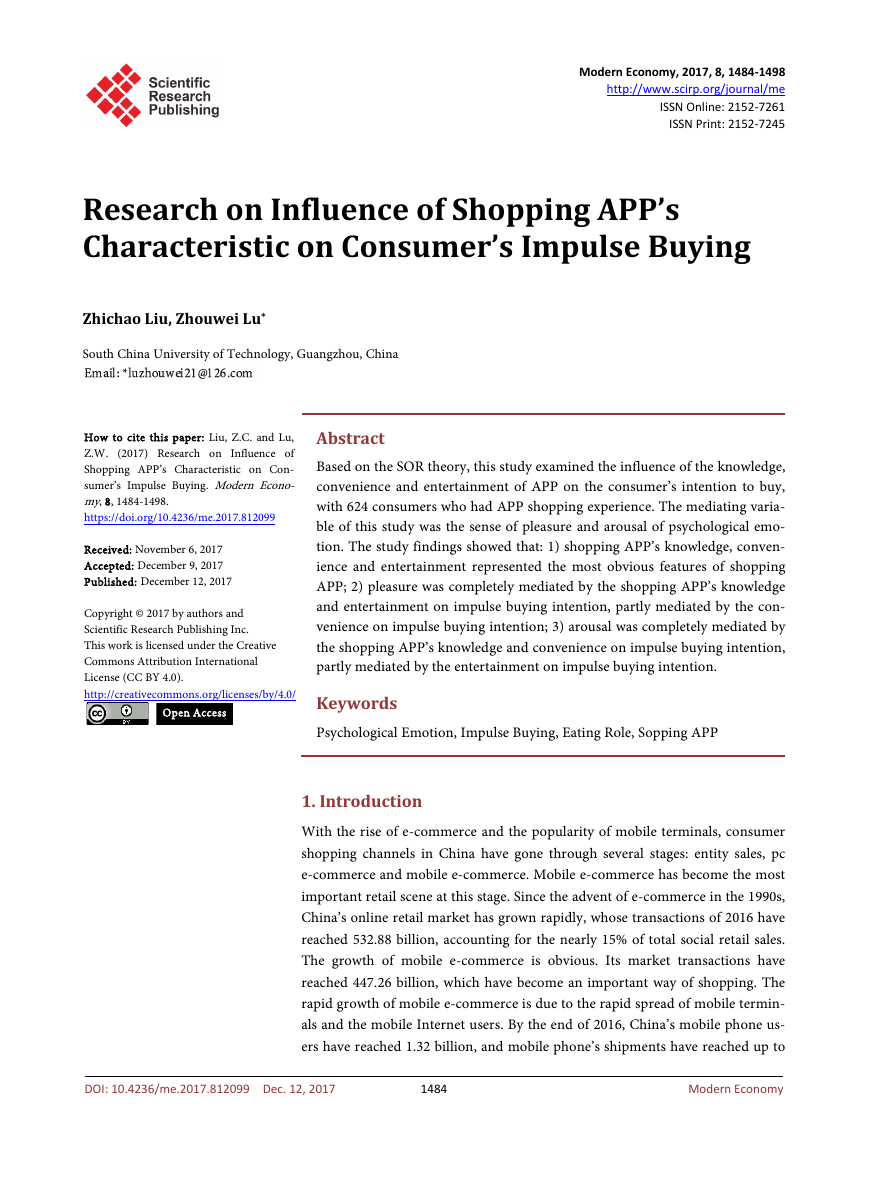
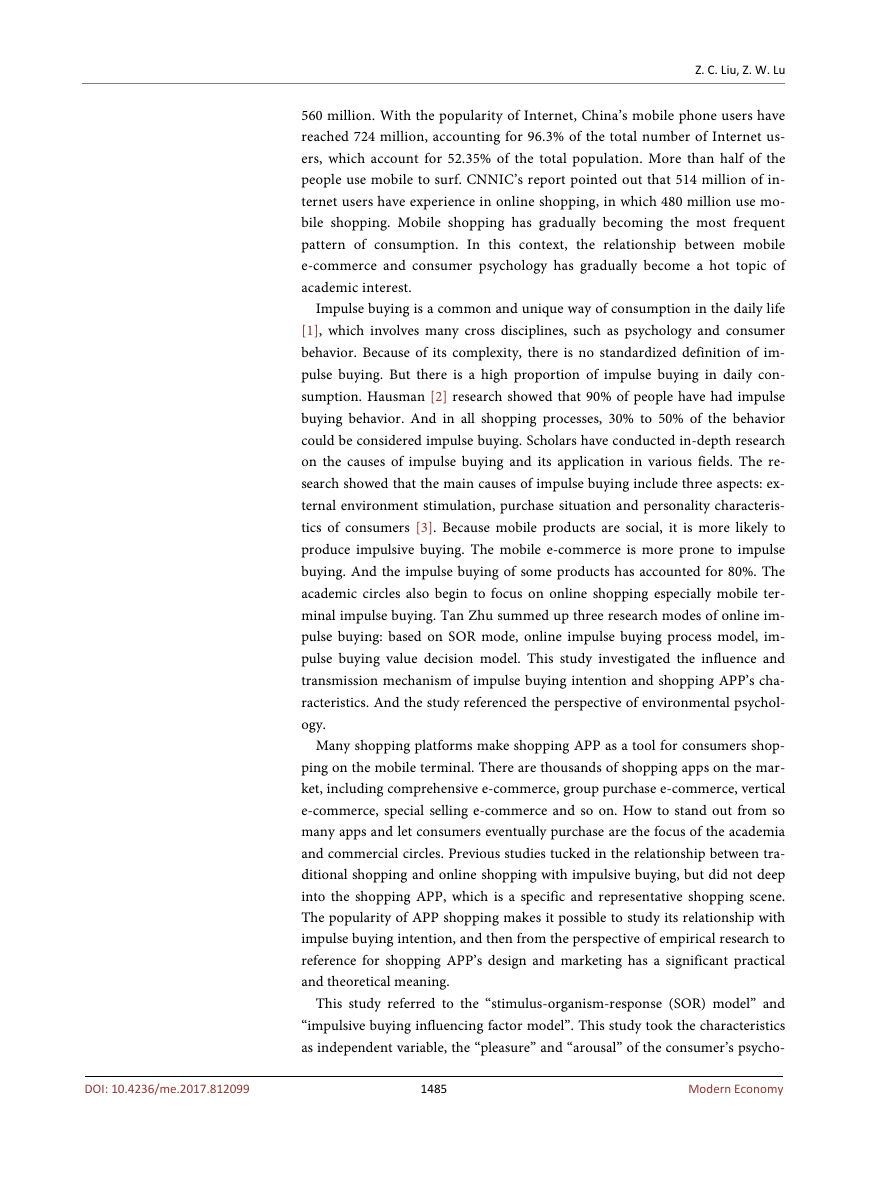
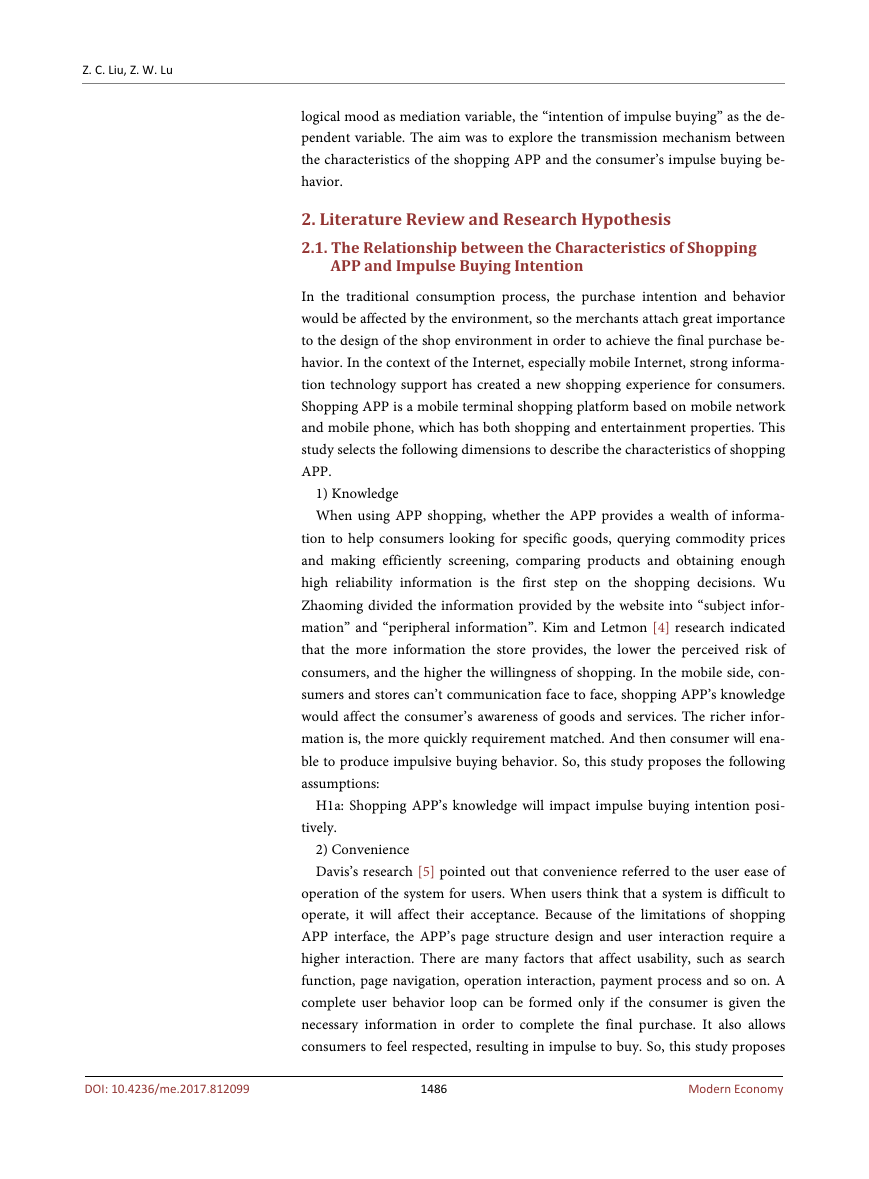
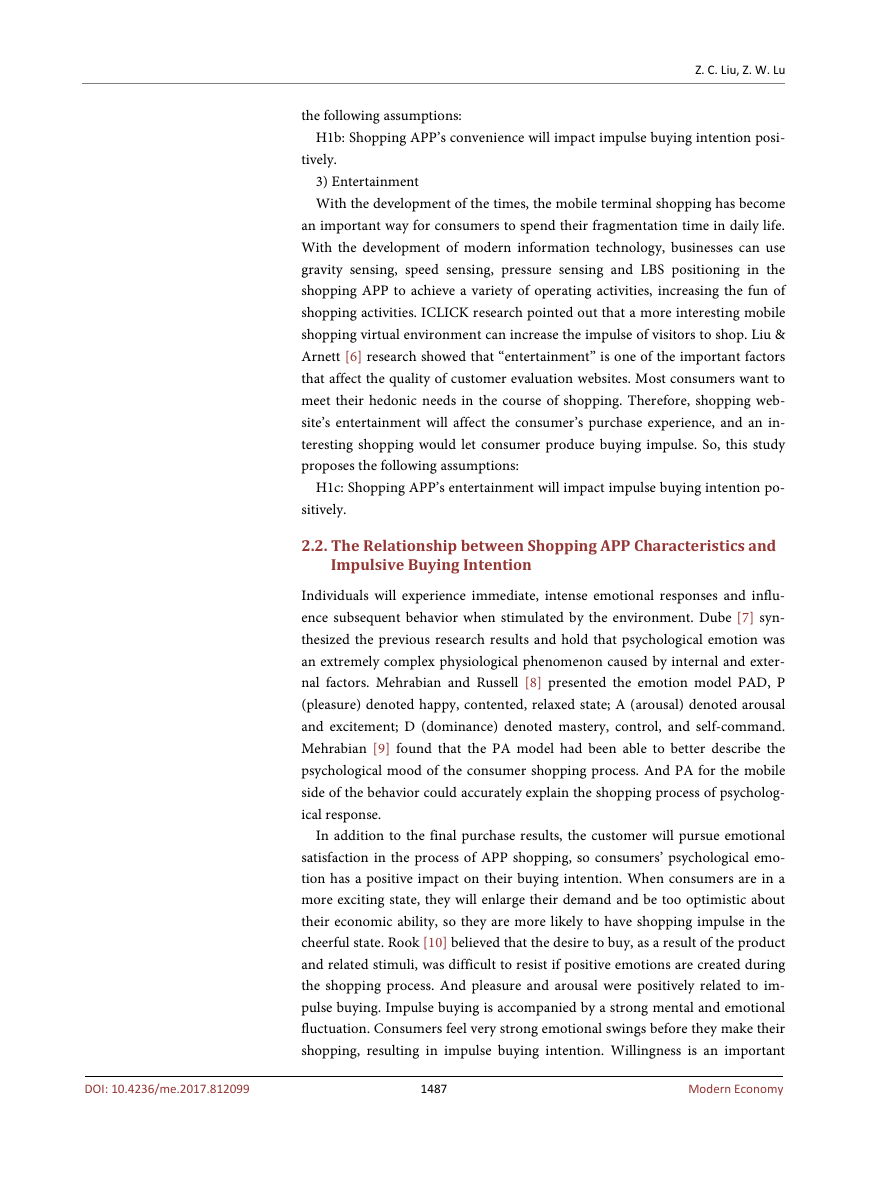
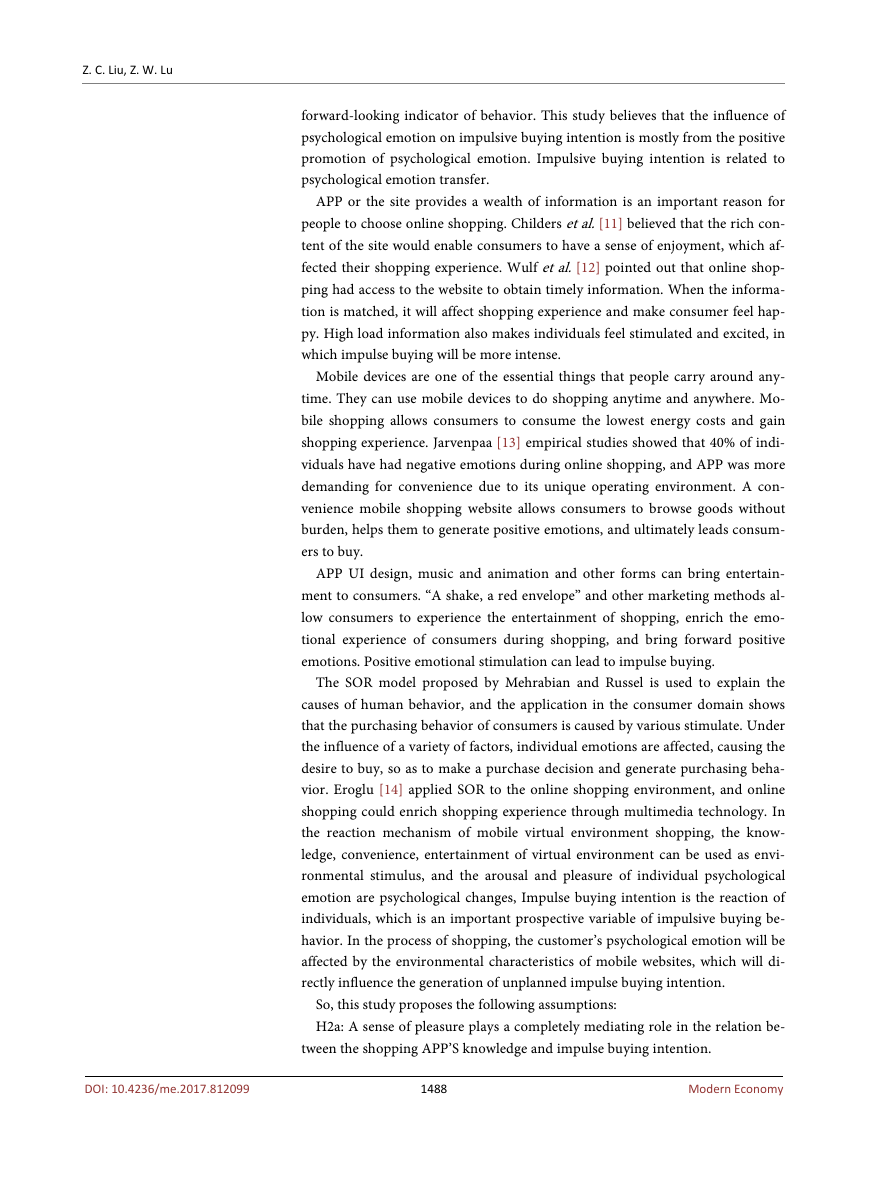
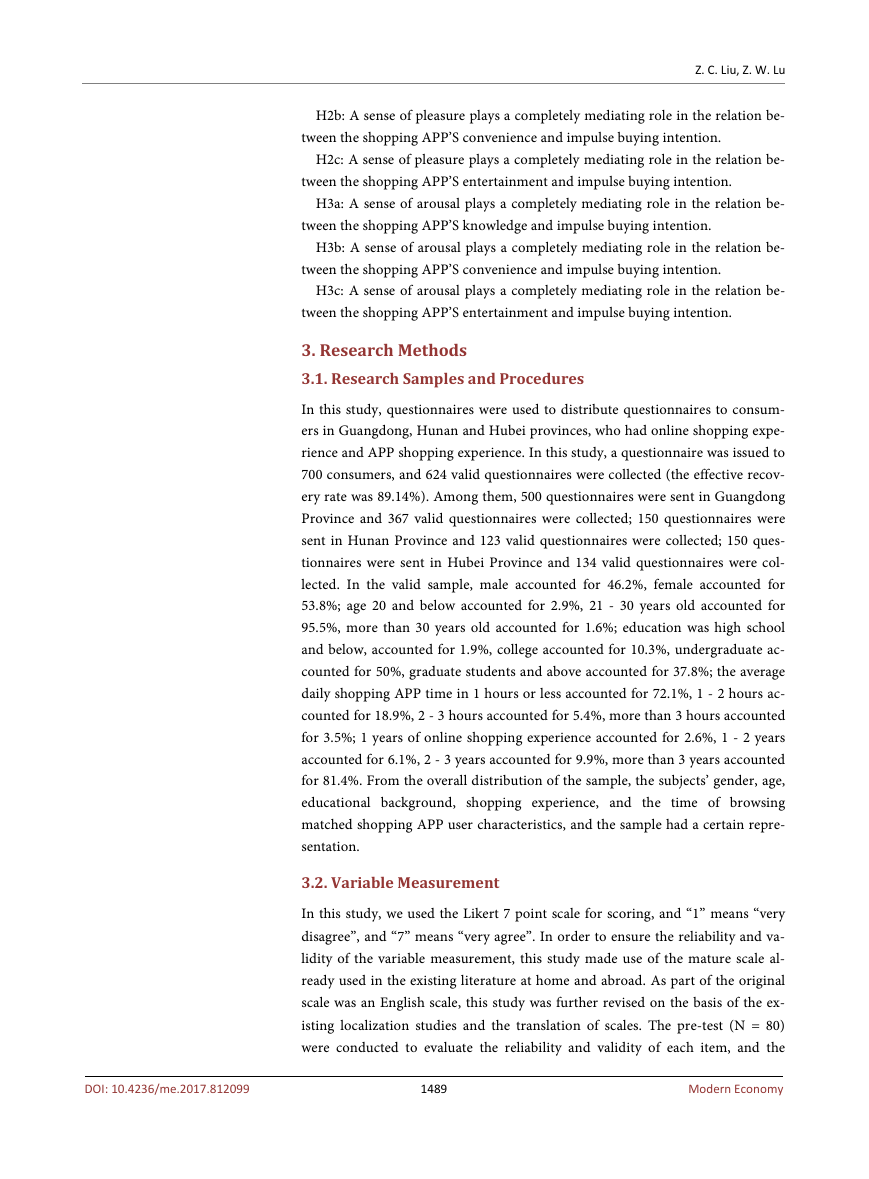










 2023年江西萍乡中考道德与法治真题及答案.doc
2023年江西萍乡中考道德与法治真题及答案.doc 2012年重庆南川中考生物真题及答案.doc
2012年重庆南川中考生物真题及答案.doc 2013年江西师范大学地理学综合及文艺理论基础考研真题.doc
2013年江西师范大学地理学综合及文艺理论基础考研真题.doc 2020年四川甘孜小升初语文真题及答案I卷.doc
2020年四川甘孜小升初语文真题及答案I卷.doc 2020年注册岩土工程师专业基础考试真题及答案.doc
2020年注册岩土工程师专业基础考试真题及答案.doc 2023-2024学年福建省厦门市九年级上学期数学月考试题及答案.doc
2023-2024学年福建省厦门市九年级上学期数学月考试题及答案.doc 2021-2022学年辽宁省沈阳市大东区九年级上学期语文期末试题及答案.doc
2021-2022学年辽宁省沈阳市大东区九年级上学期语文期末试题及答案.doc 2022-2023学年北京东城区初三第一学期物理期末试卷及答案.doc
2022-2023学年北京东城区初三第一学期物理期末试卷及答案.doc 2018上半年江西教师资格初中地理学科知识与教学能力真题及答案.doc
2018上半年江西教师资格初中地理学科知识与教学能力真题及答案.doc 2012年河北国家公务员申论考试真题及答案-省级.doc
2012年河北国家公务员申论考试真题及答案-省级.doc 2020-2021学年江苏省扬州市江都区邵樊片九年级上学期数学第一次质量检测试题及答案.doc
2020-2021学年江苏省扬州市江都区邵樊片九年级上学期数学第一次质量检测试题及答案.doc 2022下半年黑龙江教师资格证中学综合素质真题及答案.doc
2022下半年黑龙江教师资格证中学综合素质真题及答案.doc